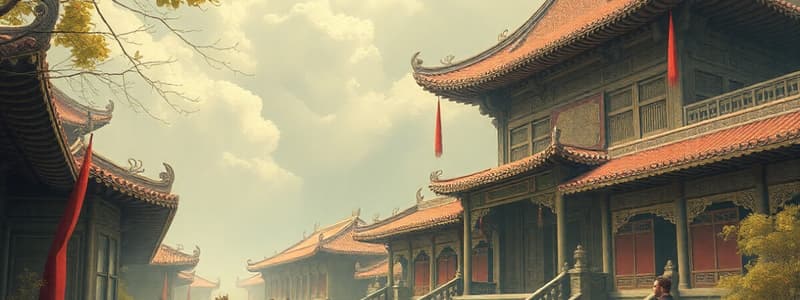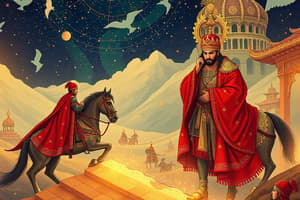Podcast
Questions and Answers
What marked the beginning of the Yuan Dynasty?
What marked the beginning of the Yuan Dynasty?
- The end of the Tang Dynasty
- The unification of Mongol clans
- The establishment of Khanbaliq
- The conquest of the Song Dynasty (correct)
Which practice was distinctive of the Mongols in China concerning government jobs?
Which practice was distinctive of the Mongols in China concerning government jobs?
- Civil service examinations were mandatory.
- Jobs were exclusively for Chinese individuals.
- Government positions were open to non-Chinese people. (correct)
- Only Mongols were appointed to government positions.
What was a consequence of Mongol rule on trade?
What was a consequence of Mongol rule on trade?
- The Mongols imposed trade tariffs that limited commerce.
- Trade between Asia and Europe was encouraged. (correct)
- Trade routes were completely closed off.
- No foreign merchants were allowed to trade.
Which ruler focused on controlling China and was responsible for the expansion of the Yuan Dynasty?
Which ruler focused on controlling China and was responsible for the expansion of the Yuan Dynasty?
How did the Mongols view cultural and religious diversity?
How did the Mongols view cultural and religious diversity?
What significant impact did Marco Polo have during Kublai Khan's rule?
What significant impact did Marco Polo have during Kublai Khan's rule?
What language and cultural practices distinguished the Mongols from the Chinese?
What language and cultural practices distinguished the Mongols from the Chinese?
Which statement accurately describes the Mongols' actions in Korea during their expansion?
Which statement accurately describes the Mongols' actions in Korea during their expansion?
Flashcards
Mongol Unification
Mongol Unification
Genghis Khan united various Mongol clans, creating a single powerful force.
Genghis Khan's Law Code
Genghis Khan's Law Code
Genghis Khan established a new legal code for the Mongols, bringing order and structure to their society.
Mongol Conquests
Mongol Conquests
The Mongols conquered tribes in the steppes, acquiring new soldiers and expanding their territory.
Khanates
Khanates
Signup and view all the flashcards
The Yuan Dynasty
The Yuan Dynasty
Signup and view all the flashcards
Mongol Cultural Separation
Mongol Cultural Separation
Signup and view all the flashcards
Mongol Impact on Trade
Mongol Impact on Trade
Signup and view all the flashcards
Marco Polo's Travels
Marco Polo's Travels
Signup and view all the flashcards
Study Notes
Mongol Expansion
- Nomadic lifestyle skills developed by Mongols included horsemanship and combat proficiency.
- Genghis Khan unified Mongol clans through a new legal code and a council of clan leaders.
- Conquest of steppe clans and major civilizations provided new soldiers and tribute payments.
- After Genghis Khan's death, the empire was divided into Khanates, with Kublai Khan controlling the eastern Khanate and focusing on China.
- Mongol rule brought both destruction and stability, fostering trade and cultural exchange between Asia and Europe while taxing traded goods.
- Mongols showed tolerance for diverse beliefs, adopting elements of conquered cultures, including learning gunpowder technology from the Chinese.
Mongol Conquest of China
- Kublai Khan established Khanbaliq (present-day Beijing) as his capital.
- Kublai Khan conquered Southern China, ending the Song Dynasty and establishing the Yuan Dynasty.
- Mongol rule in China featured Mongol dominance in leadership positions.
- Unique Mongol language, laws, and customs separated them from the Chinese, resulting in limited interaction between the groups.
- Civil service examinations were not used in the Yuan Dynasty.
- Non-Chinese individuals were eligible for government positions.
- Mongols practiced Buddhism.
- Mongol rule saw a period of prosperity and power for China.
- Chinese support for Mongol rule existed.
- Marco Polo, a Venetian traveler, resided in Khanbaliq during Kublai Khan's reign, facilitating information gathering and travel.
- Yuan Dynasty shipbuilding and sea trade expansion resulted in the spread of Chinese knowledge among various cultures.
- Mongol armies expanded into Vietnam and Korea, impacting both regions through force and negotiation. Korean officials could retain power by agreeing to Mongol control and constructing warships.
- Quanzhou, a significant trade port in Southeast China, hosted merchants from various regions, facilitating trade across continents. Emperors of Tang, Song, and Yuan dynasties permitted foreign trade activity in this location.
Studying That Suits You
Use AI to generate personalized quizzes and flashcards to suit your learning preferences.




